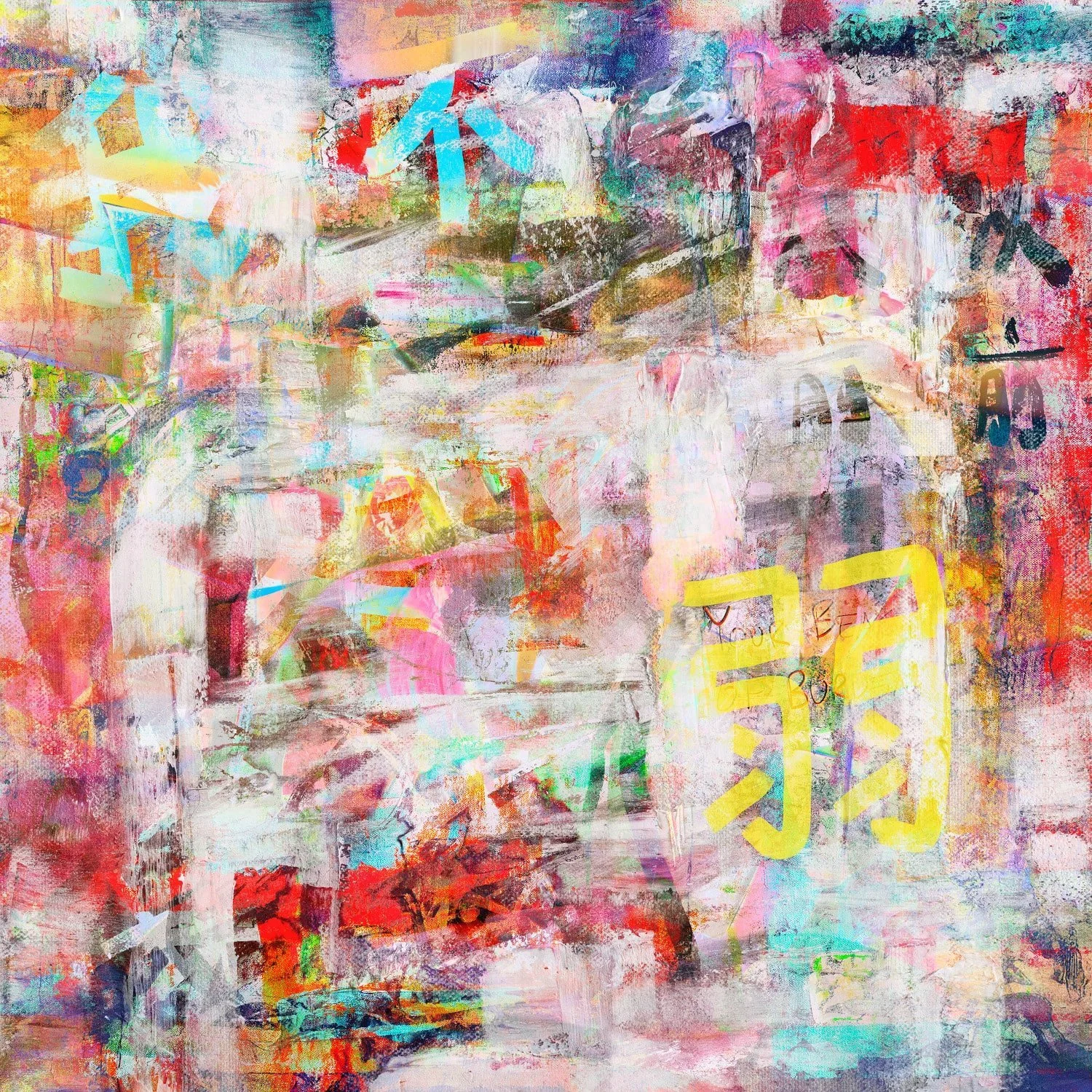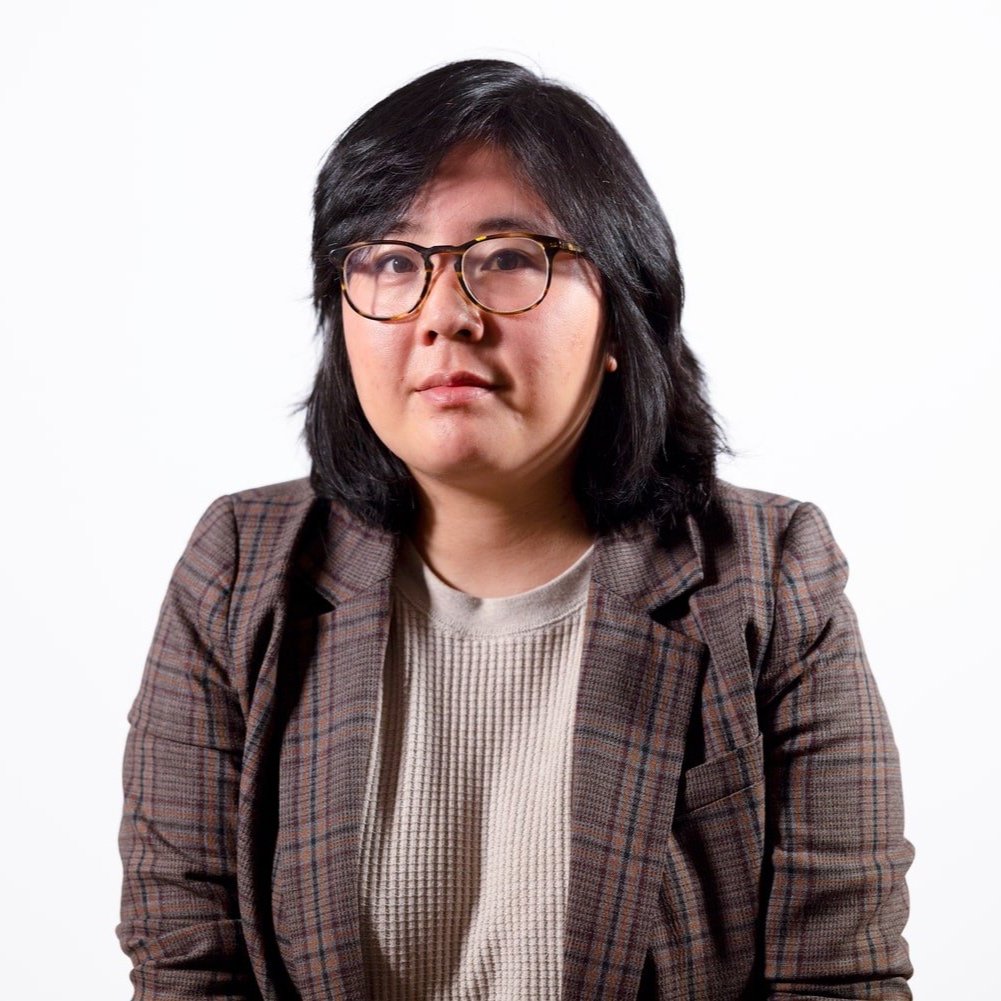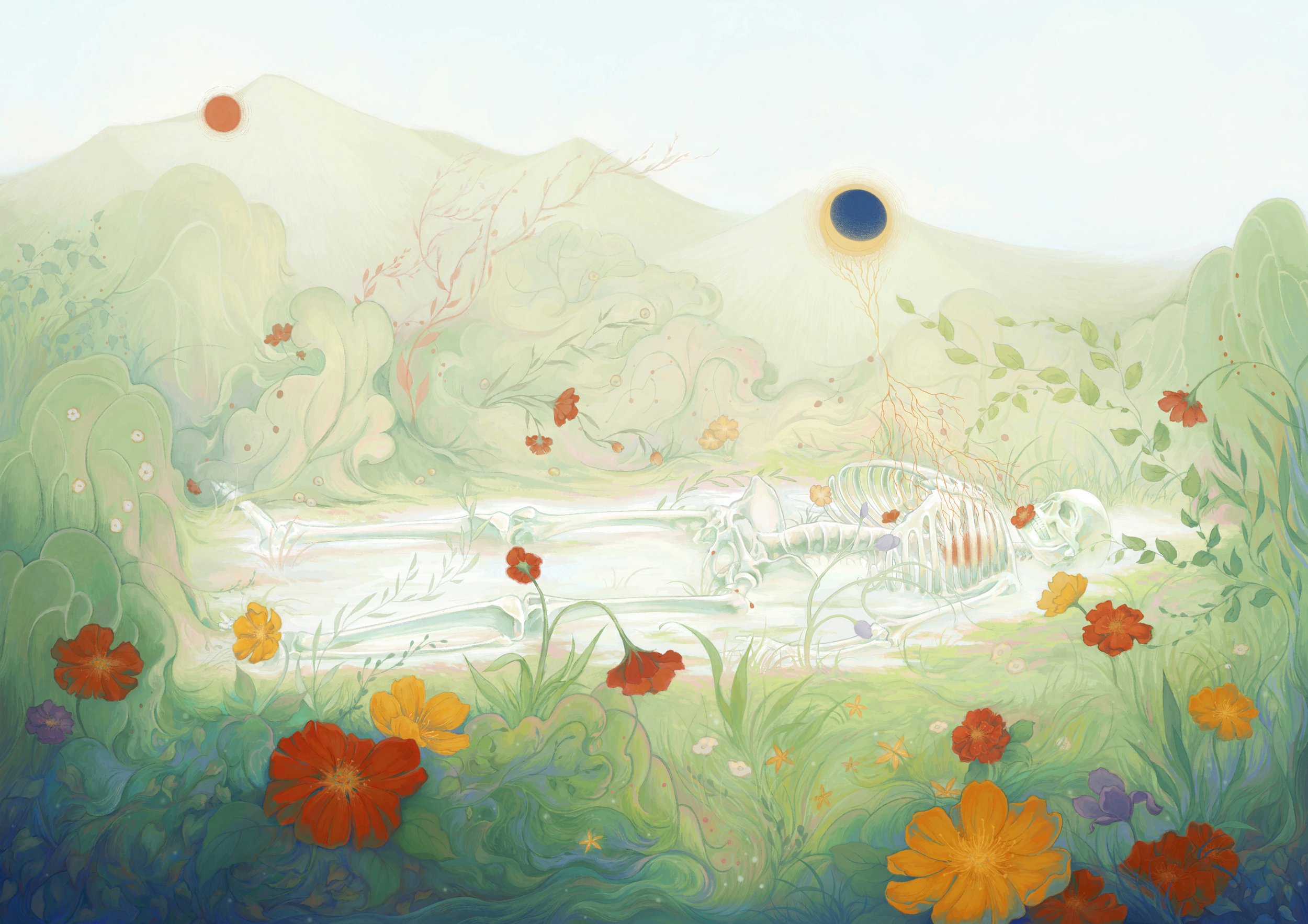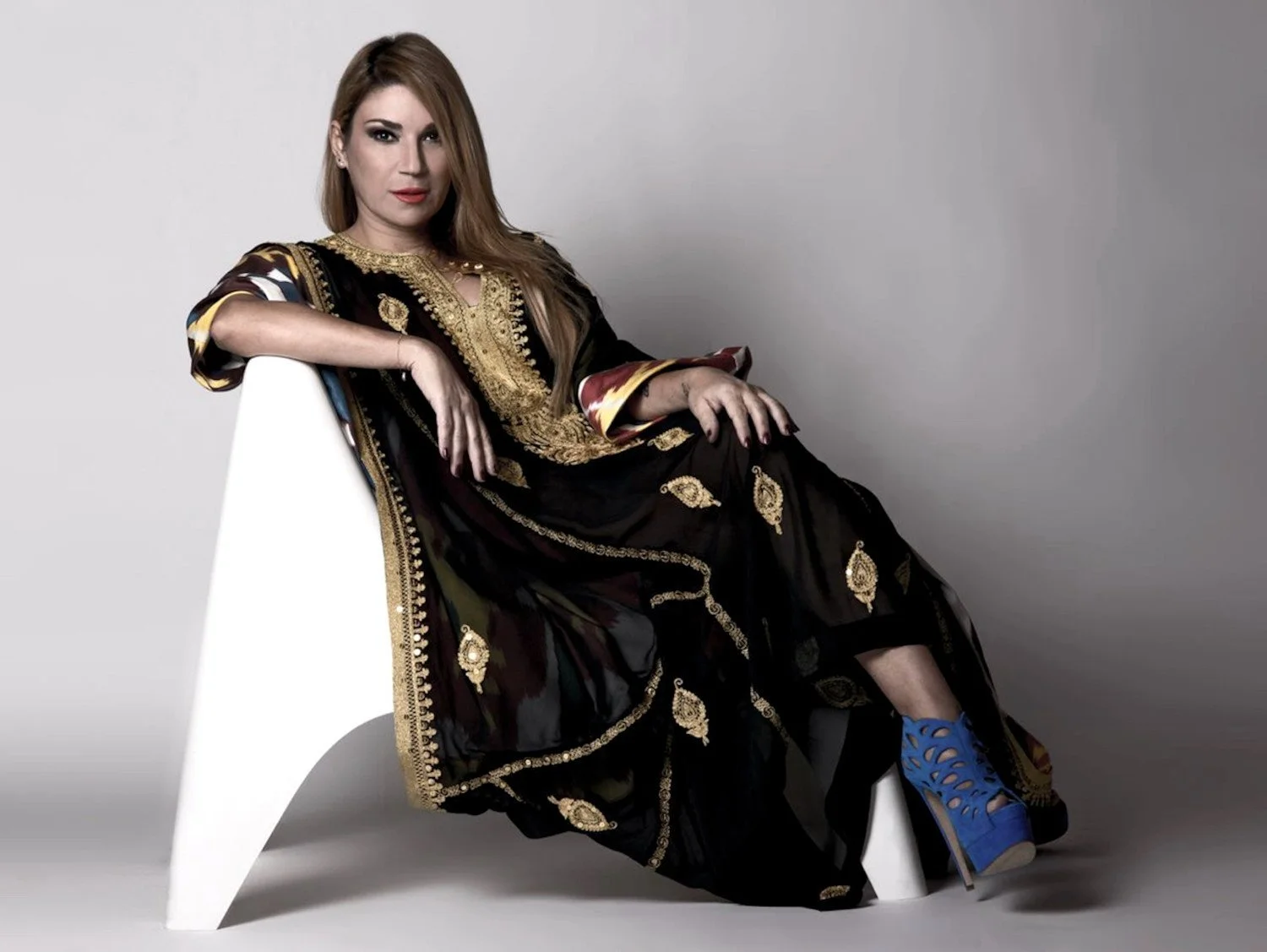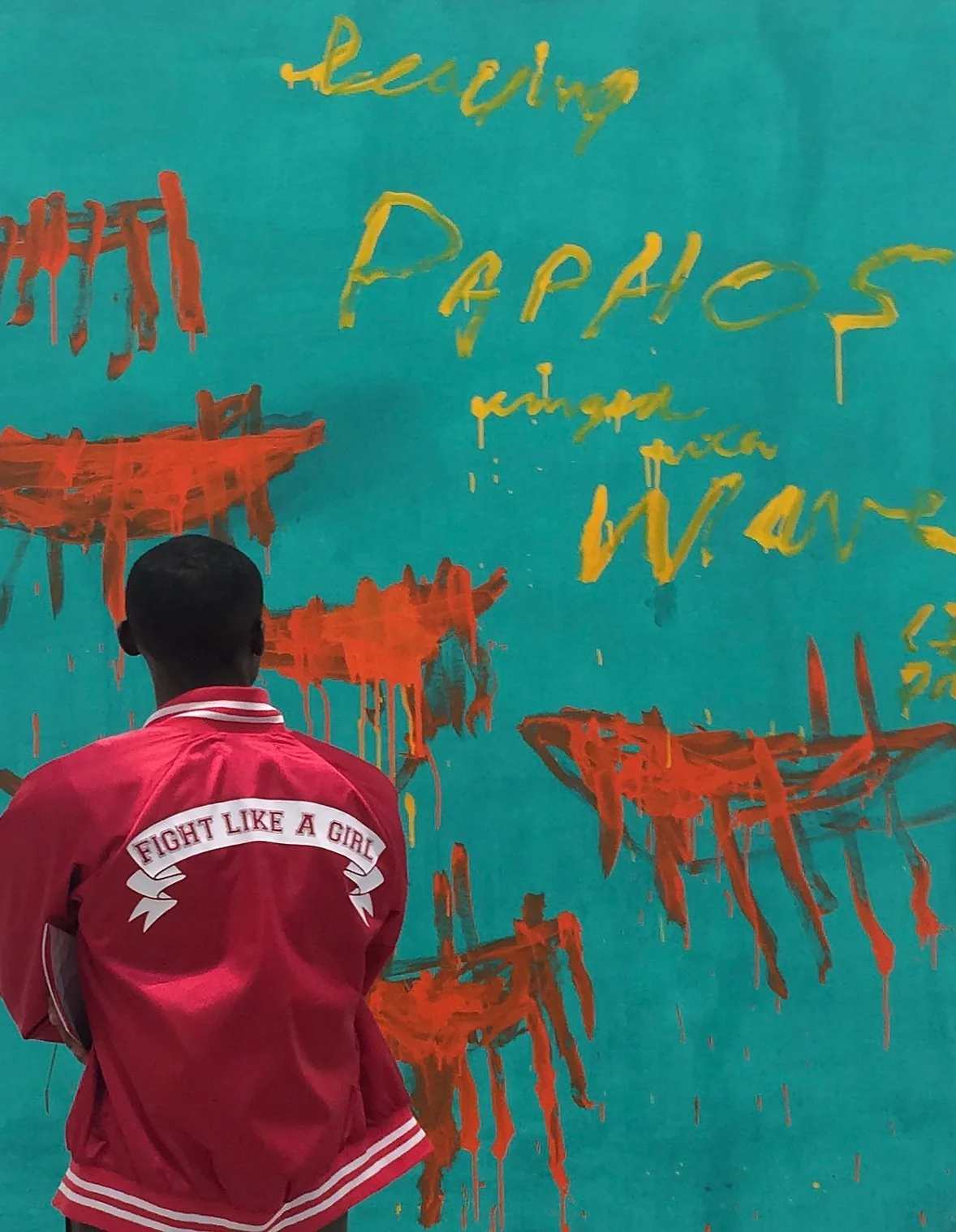10 Questions with Elaine Chao
Elaine B. Chao is a traditional-digital hybrid artist working in Queens, NY. She earned her B.A. in Art from Rutgers University, NJ, in 2013. Her art-making practice is focused on digital printmaking and animations. Expanding on traditional techniques, she first composes paintings on canvas or paper using acrylic, oil, and other mixed media. She then imports the paintings into image manipulation programs to blend, apply filters, and run actions. Her animations are rhythmic, glowing GIFs of paintings, or mock "glitches." The final digital work is printed or uploaded to an AR app for display. Ancient Chinese art, Gerhard Richter, Paul Klee, and the films of Wong Kar Wai inform her work.
She currently exhibits with Solas Studio and Pictor Gallery in New York, NY.
Elaine Chao - Portrait
ARTIST STATEMENT
“My art invites interrelation in which the viewer experiences a lightness of being. Rather than relentlessly pushing forward with the weight of personal and generational traumas, my exuberant works urge the celebration of culture and identity. The incorporation of my mother tongue alludes to the density of foreignness, the longing for understanding, and the inextricable influence of heritage on the self. Individuals can express themselves in dance, gesture, or play and cast off their burdens. Whether in its production or consumption, art involves "play." The viewer unravels a work of art and becomes involved in an exchange with the artist. I am interested in the way playing frees us to be our unique selves. Writing or gesture may express, but its meaning is enhanced by color and image. For example, many languages are pictorial or graphic. When one is unfamiliar with a pictographic language, the writing may appear to be symbols. Due to unreadability, its meaning is obscured, and the words become art objects. However, to those who may read it, the writing retains its function as discourse, and elaborates on the nonverbal aspects of my art. The totality of my artworks possesses content constructed by elements that can be disassembled into discrete parts. Cohesion results from integration that does not impinge upon the integrity of each element. Rather, writing, gesture, symbol, color, texture, drawing, and line form an assemblage of related entities. I connect this to how identity - individual or collective - can be constituted of many things and can find unity in multiplicity.
Bell Hooks has phrased the experience of being queer as: "...queer as not about who you're having sex with, that can be a dimension of it, but queer as being about the self that is at odds with everything around it and has to invent and create and find a place to speak and to thrive and to live." My series of works, "Beast of Burden", is an articulation of culture, identity, and ultimately self, amid the emotional and psychological pressure to conform, assimilate, or hide who you are. The works use the motif of monsters or aliens to stand for difference, and the way being different can make an individual an outsider or an outcast. The words and imagery invite truthful expression that embraces even the 'monstrous' sides of ourselves. Past traumas may weigh an individual down, but despite this, let us find ways to commune with one another and remember to have moments of revelry.” - Elaine Chao
Twilight Sea, archival inkjet print on canvas, 20x20 in, 2022 © Elaine Chao
Get your limited edition copy now
INTERVIEW
Let’s start with your background. How did you begin making art? And how did you develop into the artist you are today?
I was always drawing as a kid. I would make comic books about a superhero bunny named “Biscuit.” Art was a way for me to create characters and tell stories. In college, I studied video and learned the limits of that medium. I didn’t start painting until I was in my early twenties, and I was photographing my paintings for my website when I needed to edit them in Photoshop. At some point, I thought, “Heck, what if I did wild things to my paintings, instead of just adjusting the white balance and color correcting?” That was the beginning of my digital manipulation of media I was making traditionally. My experience editing video bleeds into my Photoshop process, and I’ve done animations where paintings glow or glitch. I love bringing a still image to life in simple, subtle ways where there is no narrative— opposite to what I would make as a child.
What do you wish you knew about contemporary art before you got started?
I am glad I did not know much about contemporary art when I first started. I feel as though I still don’t know very much, but I am learning. Coming into the art world without many expectations or preconceptions allowed me to develop a strong artistic identity, where I don’t feel as though I need to be palatable or conform to a particular style. Contemporary art lacks a central defining ideology, which is freeing, and you see endless forms of expression and representation. Browsing Artsy and looking at what has been made in the last half-century gets me enthusiastic about art and being a part of it all. It’s my continuing education, and I think, most importantly, I’ve learned to be fearless about putting myself into my work.
Am I Cute (Girl With Wolves), archival inkjet print on canvas, 20x20 in, 2022 © Elaine Chao
Beast of Burden IV - Obscura, archival inkjet print on canvas, 32x32 in, 2022 © Elaine Chao
In your work, you often refer to Asian cultures, both visually and in the techniques you use. How important is it for you to maintain a strong bond with your heritage and cultural background?
Heritage is a kind of remembrance that is more about relationships and identity than it is about re-assembling the past. Re-constructing a narrative—for example, the life story of an ancestor—is a way of connecting with your origins, but for anyone who is a descendant of migration, the idea of your ‘origin’ is an interesting consideration of birthplace and DNA. Cultural background enriches our sense of ‘who we are beyond our genetic code, and my relationship with my heritage is an integral part of my identity. Tradition keeps us anchored so that we do not forget who we are, while experimentation and progress bring us to new horizons.
Speaking of your work, you often incorporate pictograms and characters, which make the works both easily comprehensible or completely unreadable, depending on who is watching. What messages do you want to convey? And how does using these types of symbols and characters help you express those messages?
I use language as a means of expression in my work, but I also frame it as a barrier to understanding. When we think of aliens, one of the first things we imagine is that they speak an incomprehensible language. I am reminded of “Story of Your Life” by Ted Chiang, on which the movie Arrival is based, which is about a linguist learning an alien language. In the story, the alien being’s language is a gift to humankind. If you can read, you can decode texts and delve into a civilization’s history, but if you cannot read a foreign language, the writing becomes less meaningful and more abstracted. The ‘signified’ is occluded, and the ‘sign’ is construed only as the ‘signifier.’ However, the abstracted ‘signifier’ still conveys information, perhaps in the style of writing or the typeface. This is very true for graffiti, which is an art form that distills writing into gestural flair. I pair pictographic language with a script that I cross out or arrange into a palimpsest, again to interfere with readability. Encountering diverse representations can involve the appreciation of things we do not understand. A written statement is enduring in that it is recorded on a surface, and art is frequently viewed as immortalizing. Urban surfaces are often built up with layers of text, ads, stickers, graffiti, and other forms of art. The natural accumulation of history and the individual marks we leave on the world become ephemera that get covered up or worn away.
Beast of Burden III - Foe, archival inkjet print on canvas, 32x32 in, 2022 © Elaine Chao
Harbor Salted Light, archival inkjet print on canvas, 30x30 in, 2022 © Elaine Chao
Bop 3, archival inkjet print mounted to white sintra, 32x32 in, 2022 © Elaine Chao
In your work, you use bold colors. How did you develop this style? And why did you choose to work with these colors?
My first digital works utilized grid paintings I made while referencing “A Dictionary of Color Combinations” by Wada Sanzo. When painting, I choose my palette, knowing that it will be transformed during editing. In the final work, I end up with a much different color scheme than the base paintings. I combine colors that contrast or will layer in exciting ways—and the result of blending digitally must be unpredictable to a degree for the process to be enjoyable for me. For the most part, setting a painting to “overlay” will cast its hues on top of the base layer, and when I choose this setting, I don’t want to be surprised as much. However, when I invert and then set the layer to “difference,” I am looking for something drastic. I blend layers dozens of times, and recently I’ve been solarizing as well. Each time I blend, I am making a choice of which mode to set. I gravitate towards bolder outcomes because I want to captivate and saturate the eye. I want to evoke a spirit of celebration that pairs with the more pensive sentiments of the writing I incorporate.
You also address important themes, such as identity, community, queerness, and belonging. How important do you think art is in spreading such ideas? And what do you think is the role of an artist in that regard?
Every artist has something to say, and it is important to me that my art address themes of identity, queerness, and belonging. Being queer can be a terribly alienating experience, not just from others but from yourself. I do not think art has to be about something personal—it can be an aesthetic or intellectual pursuit. Art has always been a way for me to relate with others and commune with myself. If the artist has a role, I believe it is to bring people closer together. The audience connects with the artist when viewing the work, and art enables interrelation that goes beyond simple dialogue.
What is the most challenging part of your work? And what is the most enjoyable?
Writing about my work is the most challenging! When I make it, it is so intuitive that I am not always thinking about its significance. I most enjoy experimenting, especially when I produce something unexpected that works. It energizes me and makes me want to create more!
Beast of Burden II - Metamorphosis, archival inkjet print on canvas, 32x32 in, 2022 © Elaine Chao
Beast of Burden V - Angel Fighter, archival inkjet print on canvas, 32x32 in, 2022 © Elaine Chao
You are currently working with Solas Studio and Pictor Gallery in New York. What do you think of the art community and market? And what is your experience dealing with collectors?
I found a supportive art community in Solas Studio, which includes a Critique Club, so I get valuable feedback and get to see new work by other artists. Getting to know other artists through Solas has helped me grow my practice, and I always feel connected to the “now” in the art world. I regularly read about the art market. The prominent art fairs, such as Frieze and Art Basel, are invigorating to read about and always have notable sales. Selling at a local art fair has worked well for me, and I also think selling virtually is a successful channel. I sold virtually through a virtual exhibition hosted on Kunstmatrix, which was a pleasant surprise.
What are you working on now, and what are your plans for the future? Anything exciting you can tell us about?
Speaking of selling virtually, I have just joined the online platform Widewalls. I am excited to be represented by their online venue, Wide Gallery. I also have work in the SyArt Sorrento Festival and will be showing some AR work at the AnnMarie Sculpture Garden in Maryland. One of my newest pieces will be in a pop-up on Allen Street called “Local Fare,” hosted by Solas Studio, and I will also have a piece in their October exhibition curated by Erik LaMarca. I am waiting to hear the final word about my participation in the PASA Festival being held in Seoul this September. That’s quite a few events on the horizon. I have been busy printing!
And lastly, where do you see yourself and your work five years from now?
I am a dreamer, so my visions of the future are filled with hopes. Like sharing a wish, I believe it’s better to keep these dreams private. I will say, I hope Solas Studio remains a lovely community and that the art world remains fertile for new ideas and experimental work.

